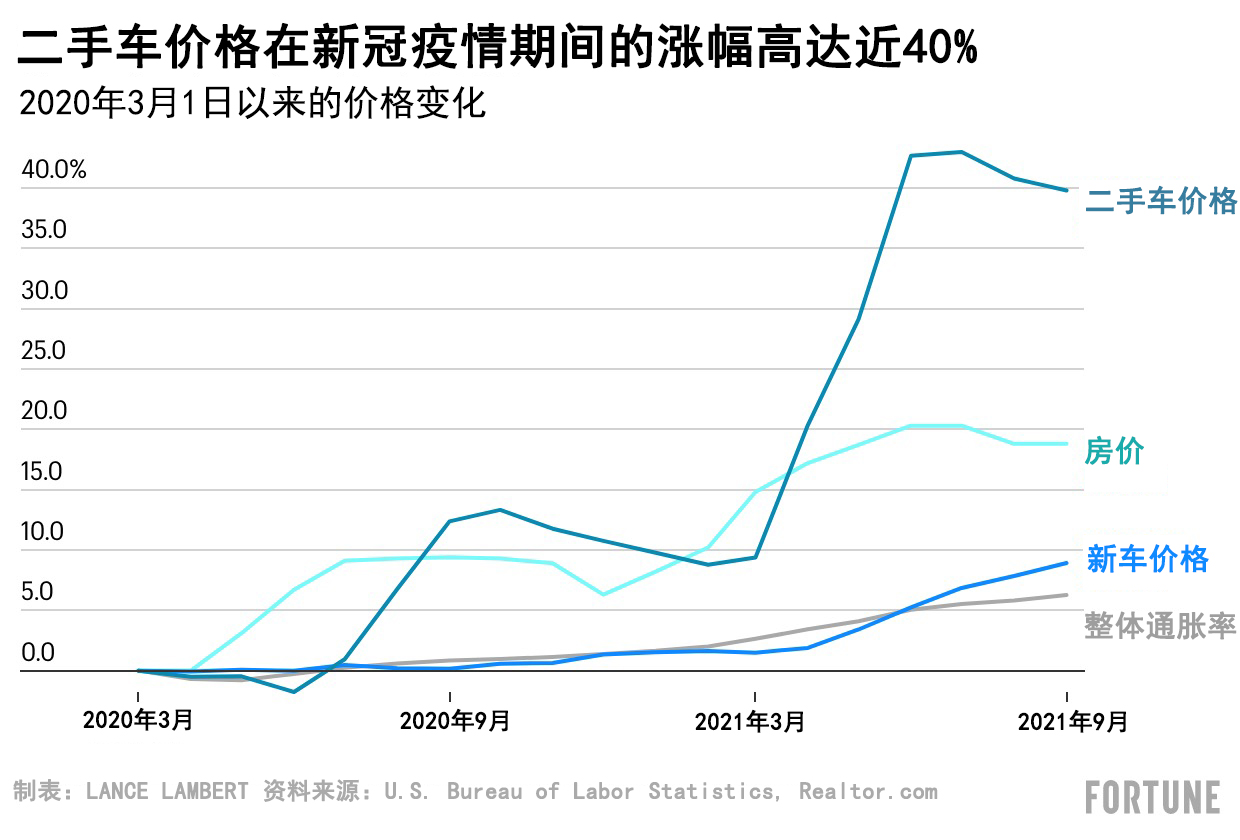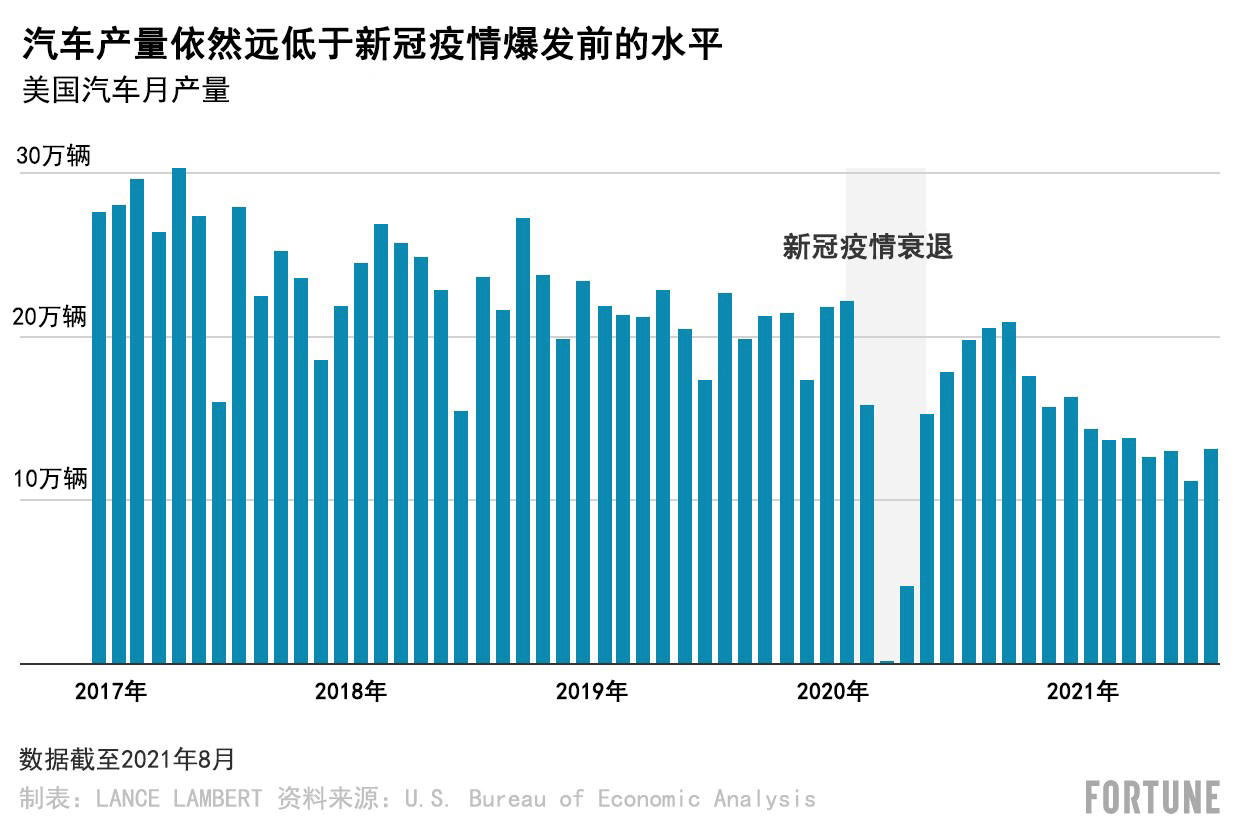过去一年中,随着新冠疫情导致供应链的中断、半导体等关键汽车零部件的短缺,以及上市新车数量的大幅减少,汽车价格一直在飙升。
就在新车价格一路高歌的同时,二手车的价格更是有过之而无不及。可售新车的匮乏让价格更为低廉的二手车市场火爆异常。美国劳工统计局的消费价格指数(U.S. Bureau of Labor Statistics’ Consumer Price Index)显示,自2020年3月以来,二手车价格的增幅达到了惊人的39.8%。同一时期,新车价格的美国劳工统计局通胀率达到了8.9%,而美国的整体通胀率为6.3%。
二手车零售商CarMax的执行副总裁兼首席营销官吉姆·利斯基向《财富》杂志透露:“经销商车场的车不多,如果你到一些车场里走走,就会发现没有多少车。目前,消费者实际上没有首选权,因此只能将目光投向第二选择,第三选择。如果他们不愿意等待厂家生产新车的话,那么就只能上二手车市场。”

利斯基指出,汽车价格依然在上涨。他说,价格“在过去几周”一直在固执地攀升,并估计“汽车平均购买价格每周都会小幅上涨100/200美元”,他在2021年10月底根据CarMax掌握的数据说道。
然而,这对消费者来说意味着什么?他们是否应该掏腰包购买,还是持币观望?为了让这些准买家更好地了解相关信息,《财富》杂志分析了造成当前这一局势的原因,以及2022年的汽车价格和库存可能的走向。
为什么二手车价格如此之高?
在新冠疫情伊始,全球汽车制造戛然而止。这并非是夸张之言:美国经济分析局(U.S. Bureau of Economic Analysis)的数据显示,2020年4月,美国汽车产量较2020年2月下滑了99%。到2020年夏季,汽车行业确实开始反弹,但好景不长:由全球供应链中断导致的零部件短缺和延迟致使美国汽车月产量再次下滑。总的来说,2020年美国汽车产量下滑了23%,而且按照当前的趋势,2021年有可能进一步下滑8%。
汽车产量的下滑程度比它一开始看起来更糟糕。受生命周期和事故的影响,汽车市场的汽车保有量持续下滑。这在业界被称为“汽车报废”的现象,加上汽车减产,让美国汽车总数在2020第二季度至2021年第一季度期间出现了下降。

然而,不断萎缩的供应链并非是推高车价的唯一因素。需求侧也一直都是一个重要推手。原因之一在于车贷利率在新冠疫情期间降到了谷底。此外,AlixPartners的汽车与工业实践董事总经理丹·赫奇称,因为担心新冠疫情而搬离大城市的人以及不愿意乘坐公共交通或拼车出行的人,“不得不去买车”。
怎样才能让价格正常化?
简而言之,需要解决供应链问题,让生产回归正常水平,从而实现供需平衡。
然而,缓解上述上游短缺和供应链问题并非易事。显而易见的供应链扭曲问题所引发的万物短缺现象并非是单方面原因造成的,何况还有这么广泛的疫情。赫奇对《财富》杂志说:“这是个别部件的短缺,而其起因包括半导体的短缺、劳动力的短缺、钢铁和树脂的分配……大量生产被中断。”他说,何况,运输和航运问题以及港口的延误是目前最大的弱点。
在这一方面,人们在最近采取了一些行动,包括美国总统乔·拜登为了减轻港口积压而要求洛杉矶港全天候运营的计划。不过,这些举措的作用是有限的。如果要提升美国本土的汽车产量,亚洲芯片和半导体产量则需要时间来满足需求。然而坏消息是,芯片短缺问题可能会持续至2023年。
2022年二手车市场对消费者来说意味着什么?
行业专家告诉《财富》杂志,二手车市场要到2022年下半年(或之后)才会开始回归常态。
Cox Automotive的首席经济师乔纳森·斯莫克对《财富》杂志说:“随着人们解决这些瓶颈以及产量不足的问题,人们最终会看到价格回归正常模式。然而在我看来,这并不意味着我们将重蹈木材市场的覆辙,该行业经历了一次重大价格纠正。”他的经济预测认为,二手车价格将继续在2022年上半年上涨,然后在明年下半年小幅回撤。
AutoNation的首席执行官迈克·杰克逊这类人认为,“受消费者对个人交通的需求以及持续的制造商供应链中断影响,消费者需求将继续超越供应”,他在公司于2021年10月的营收电话会议上说道,并表示他预计这一现象将持续至“2022年下半年”。这一评估得到了CarMax利斯基的首肯,后者预测价格在未来“9至12个月的时间内”无法回撤至2019年的水平。
AlixPartners的赫奇建议关注新经销商车场库存车停留的天数。他说,一旦这个数字增至“接近50或60天的库存水平,那么价格的常态化将指日可待。”
赫奇预测:“价格正常化的前提就是新车库存的正常化,但后者需要2022年一整年的时间。”(财富中文网)
译者:冯丰
审校:夏林
过去一年中,随着新冠疫情导致供应链的中断、半导体等关键汽车零部件的短缺,以及上市新车数量的大幅减少,汽车价格一直在飙升。
就在新车价格一路高歌的同时,二手车的价格更是有过之而无不及。可售新车的匮乏让价格更为低廉的二手车市场火爆异常。美国劳工统计局的消费价格指数(U.S. Bureau of Labor Statistics’ Consumer Price Index)显示,自2020年3月以来,二手车价格的增幅达到了惊人的39.8%。同一时期,新车价格的美国劳工统计局通胀率达到了8.9%,而美国的整体通胀率为6.3%。
二手车零售商CarMax的执行副总裁兼首席营销官吉姆·利斯基向《财富》杂志透露:“经销商车场的车不多,如果你到一些车场里走走,就会发现没有多少车。目前,消费者实际上没有首选权,因此只能将目光投向第二选择,第三选择。如果他们不愿意等待厂家生产新车的话,那么就只能上二手车市场。”
利斯基指出,汽车价格依然在上涨。他说,价格“在过去几周”一直在固执地攀升,并估计“汽车平均购买价格每周都会小幅上涨100/200美元”,他在2021年10月底根据CarMax掌握的数据说道。
然而,这对消费者来说意味着什么?他们是否应该掏腰包购买,还是持币观望?为了让这些准买家更好地了解相关信息,《财富》杂志分析了造成当前这一局势的原因,以及2022年的汽车价格和库存可能的走向。
为什么二手车价格如此之高?
在新冠疫情伊始,全球汽车制造戛然而止。这并非是夸张之言:美国经济分析局(U.S. Bureau of Economic Analysis)的数据显示,2020年4月,美国汽车产量较2020年2月下滑了99%。到2020年夏季,汽车行业确实开始反弹,但好景不长:由全球供应链中断导致的零部件短缺和延迟致使美国汽车月产量再次下滑。总的来说,2020年美国汽车产量下滑了23%,而且按照当前的趋势,2021年有可能进一步下滑8%。
汽车产量的下滑程度比它一开始看起来更糟糕。受生命周期和事故的影响,汽车市场的汽车保有量持续下滑。这在业界被称为“汽车报废”的现象,加上汽车减产,让美国汽车总数在2020第二季度至2021年第一季度期间出现了下降。
然而,不断萎缩的供应链并非是推高车价的唯一因素。需求侧也一直都是一个重要推手。原因之一在于车贷利率在新冠疫情期间降到了谷底。此外,AlixPartners的汽车与工业实践董事总经理丹·赫奇称,因为担心新冠疫情而搬离大城市的人以及不愿意乘坐公共交通或拼车出行的人,“不得不去买车”。
怎样才能让价格正常化?
简而言之,需要解决供应链问题,让生产回归正常水平,从而实现供需平衡。
然而,缓解上述上游短缺和供应链问题并非易事。显而易见的供应链扭曲问题所引发的万物短缺现象并非是单方面原因造成的,何况还有这么广泛的疫情。赫奇对《财富》杂志说:“这是个别部件的短缺,而其起因包括半导体的短缺、劳动力的短缺、钢铁和树脂的分配……大量生产被中断。”他说,何况,运输和航运问题以及港口的延误是目前最大的弱点。
在这一方面,人们在最近采取了一些行动,包括美国总统乔·拜登为了减轻港口积压而要求洛杉矶港全天候运营的计划。不过,这些举措的作用是有限的。如果要提升美国本土的汽车产量,亚洲芯片和半导体产量则需要时间来满足需求。然而坏消息是,芯片短缺问题可能会持续至2023年。
2022年二手车市场对消费者来说意味着什么?
行业专家告诉《财富》杂志,二手车市场要到2022年下半年(或之后)才会开始回归常态。
Cox Automotive的首席经济师乔纳森·斯莫克对《财富》杂志说:“随着人们解决这些瓶颈以及产量不足的问题,人们最终会看到价格回归正常模式。然而在我看来,这并不意味着我们将重蹈木材市场的覆辙,该行业经历了一次重大价格纠正。”他的经济预测认为,二手车价格将继续在2022年上半年上涨,然后在明年下半年小幅回撤。
AutoNation的首席执行官迈克·杰克逊这类人认为,“受消费者对个人交通的需求以及持续的制造商供应链中断影响,消费者需求将继续超越供应”,他在公司于2021年10月的营收电话会议上说道,并表示他预计这一现象将持续至“2022年下半年”。这一评估得到了CarMax利斯基的首肯,后者预测价格在未来“9至12个月的时间内”无法回撤至2019年的水平。
AlixPartners的赫奇建议关注新经销商车场库存车停留的天数。他说,一旦这个数字增至“接近50或60天的库存水平,那么价格的常态化将指日可待。”
赫奇预测:“价格正常化的前提就是新车库存的正常化,但后者需要2022年一整年的时间。”(财富中文网)
译者:冯丰
审校:夏林
Car prices have been surging for over a year, as the pandemic disrupted supply chains and caused shortages in critical auto components like semiconductors, resulting in a lack of new vehicles hitting the lots.
as things are for new car prices, things are even worse for used vehicles. The lack of new cars available has created an absolute frenzy in the cheaper used car market. Since March of 2020, used car prices are up a staggering 39.8%, according to the U.S. Bureau of Labor Statistics’ Consumer Price Index. During that same period, the BLS inflation measurement for new car prices is up 8.9%, while overall, U.S. inflation is up 6.3%.
“There’s just not a lot of cars out there, and if you go in and walk some lots, you’ll notice that it’s not there,” Jim Lyski, executive vice president and chief marketing officer for CarMax, tells Fortune. “The consumer doesn’t really have their first pick right now, and so they’re going down to their second pick, third pick, or they don’t want to wait for production to release new vehicles, so they’re going into the used car market.”
And prices are still on the rise, observes Lyski. He says prices have persisted in moving up “over the last few weeks,” estimating “the average purchase price of cars are inching up $100, $200 a week,” he noted late last month based on CarMax’s vantage point.
But what does this mean for consumers? Should they pony up and pay these prices, or hold out for future deals? To better inform would-be buyers, Fortune explored how we got here, and where prices and inventory might be headed in 2022.
Why are used car prices so high?
At the onset of the pandemic, auto manufacturing across the globe came to a screeching halt. That’s not an exaggeration: In April 2020, the U.S. saw auto production drop 99% from February 2020 levels, according to U.S. Bureau of Economic Analysis data. By the summer of 2020, the automotive industry did begin to rebound, but that was short-lived: Component shortages and delays—caused by a disrupted global supply chain—caused monthly U.S. auto production to fall again. In total, U.S. car production fell 23% in 2020, and it’s currently on pace to fall another 8% in 2021.
The decrease in vehicle production is worse for the market than it might first appear. The car market is continuously losing vehicles to a combination of life cycles and accidents. That phenomenon, referred to in the industry as “car scrappage,” combined with decreased auto production, saw the total number of vehicles in the U.S. decline between the second quarter of 2020 and the first quarter of 2021.
But shrinking supply isn’t the only factor driving prices higher. There has been a big uptick on the demand side, too. Some of that can be attributed to interest rates on auto loans hitting rock bottom levels during the pandemic. In addition, Dan Hearsch, a managing director in the automotive and industrial practice at AlixPartners, says people moving out of big cities and not wanting to take public transportation or ride sharing as a result of COVID-19 health concerns “has driven them to buy vehicles.”
What will it take for prices to normalize?
The simple answer is for supply chain issues to get worked out and production to return to normal levels so that supply and demand can balance out.
But easing those upstream shortages and supply chain issues won’t be easy. The well-documented supply chain kinks that are causing the so-called everything shortage don’t have one culprit, save for the pandemic broadly. “It’s a shortage of individual components, which is caused by a shortage of semiconductors, shortages of labor, allocation of steel and resin…There’s lots of disruption,” Hearsch tells Fortune. Not to mention, transportation and shipping issues and delays at ports, he suggests, “are the biggest weak spot at this point.”
On that front, some actions have been taken of late, including President Joe Biden’s deal to open the Port of Los Angeles 24/7 in an effort to alleviate backlogs. But that can only do so much. For auto production to ramp up domestically, chip and semiconductor production in Asia needs time to catch up with demand. The bad news? That chip shortage, in particular, could stretch into 2023.
What can consumers expect in the 2022 used car market?
Industry experts tell Fortune it will likely take well into 2022 (or beyond) for the used car market to start to return to normal.
“As you solve the bottlenecks, and you solve the lack of production, you’ll eventually start to see normal price patterns. But my view is that does not mean we will approach something like what you saw with lumber—which had a major price correction,” Jonathan Smoke, chief economist at Cox Automotive, tells Fortune. His economic forecast has used car prices continuing to rise through the first half of 2022 followed by a small price pullback in the second half of next year.
Others like Mike Jackson, the CEO of AutoNation, note that “consumer demand continues to outpace supply, driven by consumer desire for personal transportation and ongoing manufacturer supply chain disruption,” he said on the company’s most recent earnings call in October, adding that he expects that to continue “well into 2022.” That assessment is shared by CarMax’s Lyski, who doesn’t foresee prices heading back down to 2019 levels “anytime in the next nine, 12 months.”
Hearsch of AlixPartners suggests keeping an eye on the number of days inventory sits on new dealer lots. Once that ticks up “closer to 50 or 60 days of inventory, that’s when you would expect a normalization of pricing,” he says.
“Prices are going to normalize…when new car inventory normalizes, which is going to take all of 2022,” Hearsch predicts.






